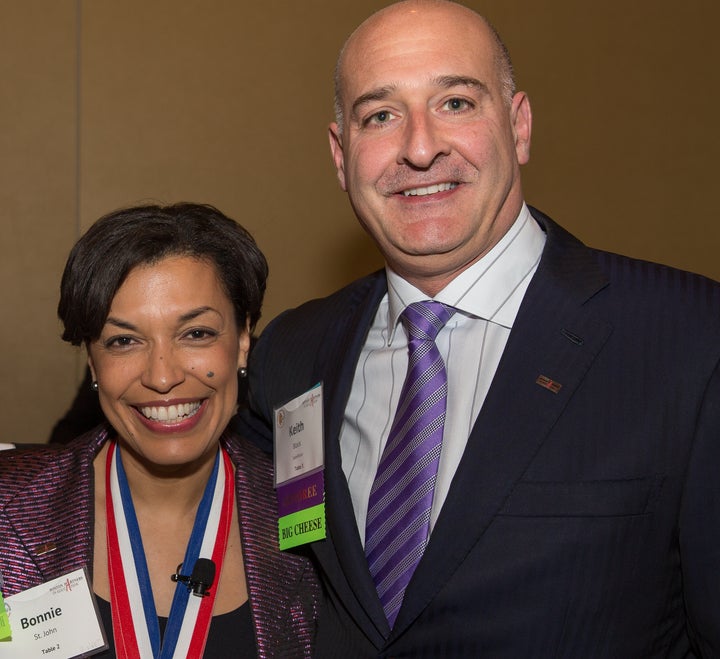
Keith Block, Vice Chair, President of Salesforce
On the eve of Equal Pay Day last year, I sat at a charity dinner in Boston with two Salesforce execs who were both kvelling about the way their company had boldly disrupted the corporate mindset on the gender gap. Instead of exhorting leaders to work toward equity, their CEO, Marc Benioff, simply mandated that his company would eliminate unequal pay. Benioff raised salaries of women and some men to correct any pre-existing pay disparities across their entire 17,000-person workforce. That’s it—he solved the pay gap problem in one fell swoop. It was so simple, yet it surprised someone like me who has worked with women business leaders for decades. Talking with Keith and Karen about the positive impact this courageous move had on their company, I realized in that moment: to get the results you want, you must change policy; not just change people’s minds.
How can it be that with so much research showing companies are more profitable when there is gender diversity in leadership, that the World Economic Forum still predicts the gender gap won’t close entirely until 2186? That’s almost 170 years away!
Although the flagrant and explicit biases in the days of TV’s “Mad Men” are unacceptable today, we know that unconscious bias remains pervasive and pernicious. Iris Bohnet, author of What Works: Gender Equality by Design, writes, “Much psychological research shows that we cannot help but put people into categories. It rarely is a conscious thought process that informs our thinking about demographic groups.
Rather, when we learn the sex of a person, gender biases are automatically activated, leading to unintentional and implicit discrimination.” And it isn’t just men discriminating against women—we women do it to ourselves as well. In response, advocates for women (like me) have spent decades launching programs to combat unconscious gender bias in the workplace: awareness training, women’s leadership training, sponsorship matching, and much more. But, as Bohnet points out, implementation is difficult, expensive, and results in only limited success. Why isn’t it working?
We must continue to educate ourselves about our biases and try to lean against them, but waiting for people’s attitudes to shift as a group before we can see the results isn’t a viable business strategy. Think of it this way: in what other area would we ignore clear and incontrovertible research on actions that make our businesses more profitable and, instead, just wait around until employees “feel like” engaging in them? It’s absurd, yet it happens every day. Anyone who is truly committed to business competitiveness and success should be screaming from the rafters for concrete policy decisions like the mandate at Salesforce. But how? The good news is there are some sweeping examples that begin to shift the dialogue.
Orchestras are a great example of taking real policy action that builds on an understanding of unconscious bias. According to Bohnet, in 1970, only 5 percent of musicians performing in the top five orchestras in the United States were women. Today, women compose more than 35 percent of the musicians in our country’s most acclaimed orchestras. Why? Blind auditions. The Boston Symphony Orchestra stepped out with a bold initiative and demanded their musicians audition behind a screen, eliminating any potential gender bias. The music would speak for itself. After implementing this policy, the quality of their talent pool increased so dramatically that almost all major orchestras around the country have now put this bias-smashing procedure into practice.
As a person with a disability, it is natural for me to compare gender biases with ability discrimination. Prior to the Americans with Disabilities Act of 1990 (ADA), we were often told that things would get better as people became more comfortable with us in society. What we saw was the reverse; attitudes began to improve only after curb cuts, accessible bathrooms, and other mandated accommodations allowed people with disabilities (PWDs) to travel, work, study, and live in the world more easily. Incidentally, PWDs still face shocking levels of discrimination in the workplace, so we should all be advocating for concrete action in this arena, too.
This issue isn’t just about fairness or getting women what they deserve. If companies want to compete in a global economy and maximize profitability, they need more women leaders. So how do we get there? I hate to say we have still have to “start small,” but even small steps can be effective if they truly move the needle. The Salesforce pay mandate wouldn’t have coalesced if women were never in the room where the big decisions were made. An interim step was a program called “Women’s Surge.” This initiative required that all meetings at Salesforce contain at least 30 percent women. Women received more access to decision making…and things changed.
We need to build on all the work we’ve done to change attitudes and start looking for bold policy steps to change the dynamic of the way we work, hire, promote, and pay. In honor of international Women’s Day 2017 - #IWD2017, we all need to #BeBoldForChange.
